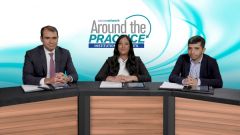
Patient Case 1: Relapsed/Refractory MM Managed With Teclistamab
Centering discussion on two clinical cases of patients with relapsed/refractory multiple myeloma, expert panelists highlight the use of BCMA-targeted teclistamab in this setting.
Episodes in this series

Transcript:
Ajai Chari, MD, PhD:Hello and thank you for joining me today on this Cancer Network Frontline program titled “Bispecific Antibodies in the Treatment of Multiple Myeloma.” My name is Ajai Chari. I'm a Professor of Medicine and the Director of Clinical Research at the Icahn School of Medicine at Mount Sinai, New York. It's my privilege today to be joined by a panel of experts in multiple myeloma. I'd like to have each of my esteemed colleagues introduce themselves, starting with Dr Krina Patel.
Krina K. Patel, MD, MSc: Hi. Thank you. I'm Dr Krina Patel, Associate Professor in the Department of Lymphoma Myeloma at UT MD Anderson Cancer Center in Texas.
Ajai Chari, MD, PhD:Dr Al Garfall?
Alfred L. Garfall, MD, MS: Hi, Alfred Garfall, Assistant Professor of Medicine at the Pearlman School of Medicine at the University of Pennsylvania.
Ajai Chari, MD, PhD:Sham Mailankody?
Sham Mailankody, MD: Hi, Sham Mailankody. I'm an Associate Attending in the myeloma service and the cellular therapy service at MSKCC in New York.
Ajai Chari, MD, PhD:Thank you for joining me today. In today's program, we're going to discuss key updates on bispecific antibodies in the treatment of multiple myeloma. We'll review updates on the efficacy and adverse effect management relating to bispecifics and then share our insights on how these updates can be applied into clinical practice in patients with multiple myeloma. Let's begin the program.
Alfred L. Garfall, MD, MS: This is a 72-year-old female with IGA lambda multiple myeloma, who had gone through standard first-line therapy initially with lenalidomide, bortezomib, and dexamethasone. Went on to consolidate her response with high dose melphalan and autologous stem cell transplant and received lenalidomide maintenance. She developed progressive disease. Eventually became refractory to lenalidomide, daratumumab, and carfilzomib. She was treated with teclistamab and achieved a stringent CR. We didn't talk too much in this presentation about her initial course with teclistamab because we wanted to focus on some of the adverse events that can develop. After achieving a stringent CR for many months, she received intravenous immunoglobulin as infection prophylaxis to maintain IgG levels above 400. Received acyclovir to prevent herpes virus and shingles. Received evusheld prophylaxis for COVID-19 and TMP-SMX to prevent pneumocystis pneumonia. After 18 months of therapy, she developed upper respiratory infection symptoms and tested positive for COVID-19. Teclistamab was held after the diagnosis, and she was treated with paxlovid. She had a prolonged upper respiratory syndrome and persistently positive COVID-19 RT-PCR test for several weeks. Into this course, she had a flare of her upper respiratory symptoms with a new cough 2 months after her first COVID-19 positive test. A respiratory viral panel showed a new rhinovirus infection. Her symptoms gradually improved, and her myeloma remained in a complete response throughout this time that she was off teclistamab for these infections. About 3 months after the initial COVID-19 diagnosis, her COVID-19 RT-PCR turned negative. Resumed teclistamab after repeating the step-up dosing and continues teclistamab with an ongoing anti-myeloma response.
Ajai Chari, MD, PhD:The second case is a 63-year-old African American male with right hip pain, classical myeloma, anemialytic lesions, M-spike paraproteins listed there, 90% marrow involvement, Durie-Salmon three, ISS2, revised stage 2. He did have 1114 translocation, and he had lytic lesions on imaging back in 2017. Next slide. He has had over the ensuing few years, 6 different lines of therapy as summarized there, including bortezomib, cyclophosphamide and DEX, high dose melphalan, isatuximab and carfilzomib, daratumumab and pomalidomide, novel antibody-drug conjugate and most recently, the daratumumab-bortezomib along with venetoclax. All of those worked for a while, but then he eventually progressed. He gets on teclistamab back in 2020, actually completed step up dosing with no CRS and went to biweekly dosing. He did require intermittent growth factor support and he did present with a grade 4 pericardial effusion requiring a pericardial synthesis but subsequent, which was due to a subspecies. He did get IV antibiotics for that but has been maintaining monthly teclistamab now with monthly IVIG with no recurrence of infection. You can see that the bone lesion in the spine that was initially present in May, and the thoracic spine has resolved. His M-spike had been going up prior teclistamab as had the light chains, and both plummeted. In fact, the light chains, you can't even see because the myeloma is so well controlled, and he remains in an MRD negative stringent CR for over a year and a half. His M-spike had been going up prior teclistamab as had the light chains, and both plummeted. In fact, the light chains, you can't even see because the myeloma is so well controlled, and he remains in an MRD negative stringent CR for over a year and a half. Both these cases highlight the excitement in myeloma where historically to get a drug under accelerated approval, we needed a 20% to 30% response rate. Well, now it looks like 60% to a 100% is the new 20 to 30 with these T-cell redirections. It's a whole new era. Patients like these are getting deeper and more durable remissions than they've had with almost all their prior lines of therapy. It's a game-changer. We owe this target BCMA a lot of credit. It's specific to myeloma and the bispecifics. Some of us call them double-sided tape or handcuffs but basically, you're bringing T-cell up right against to the myeloma. What's again striking is in patients with 5 to 7 lines of prior therapy where we expect their T-cell to have been beaten up, we're able to get these outstanding responses by bringing those T cells into proximity with the myeloma expressing BCMA target, and then the release of perforin granzymes leading to the cell death of the myeloma target. One of the unique things about BCMA is it is internalized so there are antibody-drug conjugates targeting this as well as CAR-Ts. We'll get into all the different strategies and the choices we have. It's great for patients to have these choices.
Transcript edited for clarity.
Newsletter
Stay up to date on recent advances in the multidisciplinary approach to cancer.






















































































